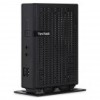ViewSonic SC-T45 SC-T35 / SC-T45 ViewSonic Device Management (English) - Page 5
Configuring Client Settings
 |
View all ViewSonic SC-T45 manuals
Add to My Manuals
Save this manual to your list of manuals |
Page 5 highlights
3.3.5 Discovering Clients in a Specified Range of IP Addresses 37 3.3.6 Creating and Managing an IP Range List 38 3.3.7 Discovering Clients using a Predefined IP Range List 39 3.4 Managing All Your Clients 41 3.4.1 Thin Clients Tab Overview 41 3.4.2 Available Tasks at a Glance 42 3.4.3 Creating Client Groups 43 3.4.4 Managing Client Groups 44 3.4.5 Moving Clients to Another Group 45 3.4.6 Deleting Clients from a Group 46 3.4.7 Understanding Client Status Icons 47 3.4.8 Client Settings 48 3.4.9 Creating Setting Profile Groups 50 3.4.10 Managing Setting Profile Groups 51 3.4.11 Creating Client Setting Profiles 52 3.4.12 Managing Client Setting Profiles 55 3.4.13 Using Individualized Client Settings 58 3.4.14 Using Hybrid Client Settings 59 3.4.15 Pushing Settings to Clients through Your Local Network 61 3.4.16 Pulling Client Settings through Your Local Network 65 3.4.17 Editing or Viewing the Basic Information about a Client 68 3.4.18 Rebooting Clients through Your Local Network 69 3.4.19 Shutting Down Clients through Your Local Network 72 3.4.20 Waking Clients through Your Local Network 75 3.4.21 Updating Client Firmware 78 3.4.22 Installing Software Packages 79 3.4.23 Taking Client Snapshots 80 3.4.24 Restoring Client Snapshots 82 3.4.25 Assisting a Client User Remotely 82 3.4.26 Digging Out Profiles, Clients, or Event Logs with Quick Search 84 3.4.27 Digging Out Clients with Filters 85 3.4.28 Managing Your Filters 87 3.5 Viewing and Managing Event Logs 89 3.5.1 Logs Tab Overview 89 3.5.2 Available Tasks at a Glance 89 3.5.3 Viewing Event Logs 90 3.5.4 Exporting Event Logs 91 3.5.5 Emptying Event Logs 91 3.6 Viewing Software Information 93 3.6.1 About Tab Overview 93 3.6.2 Available Tasks at a Glance 93 3.6.3 Viewing Information on ViewSonic Device Manager 94 3.6.4 Viewing ViewSonic Contact Information 94 3.6.5 Viewing ViewSonic Software License Agreement 94 3.7 Accessing ViewSonic Device Manager Remotely with a Web Browser 95 4 Configuring Client Settings 100 4.1 Desktop Virtualization and Client Configuration 101 4.2 Client Settings at a Glance 101 4.3 Editing or Adjusting a Group Configuration 104 4.4 Editing or Adjusting an Individual Configuration 107 4.5 Configuring Client Settings with ViewSonic Client Setup 108 4.6 Certificate Management and Deployment 109














